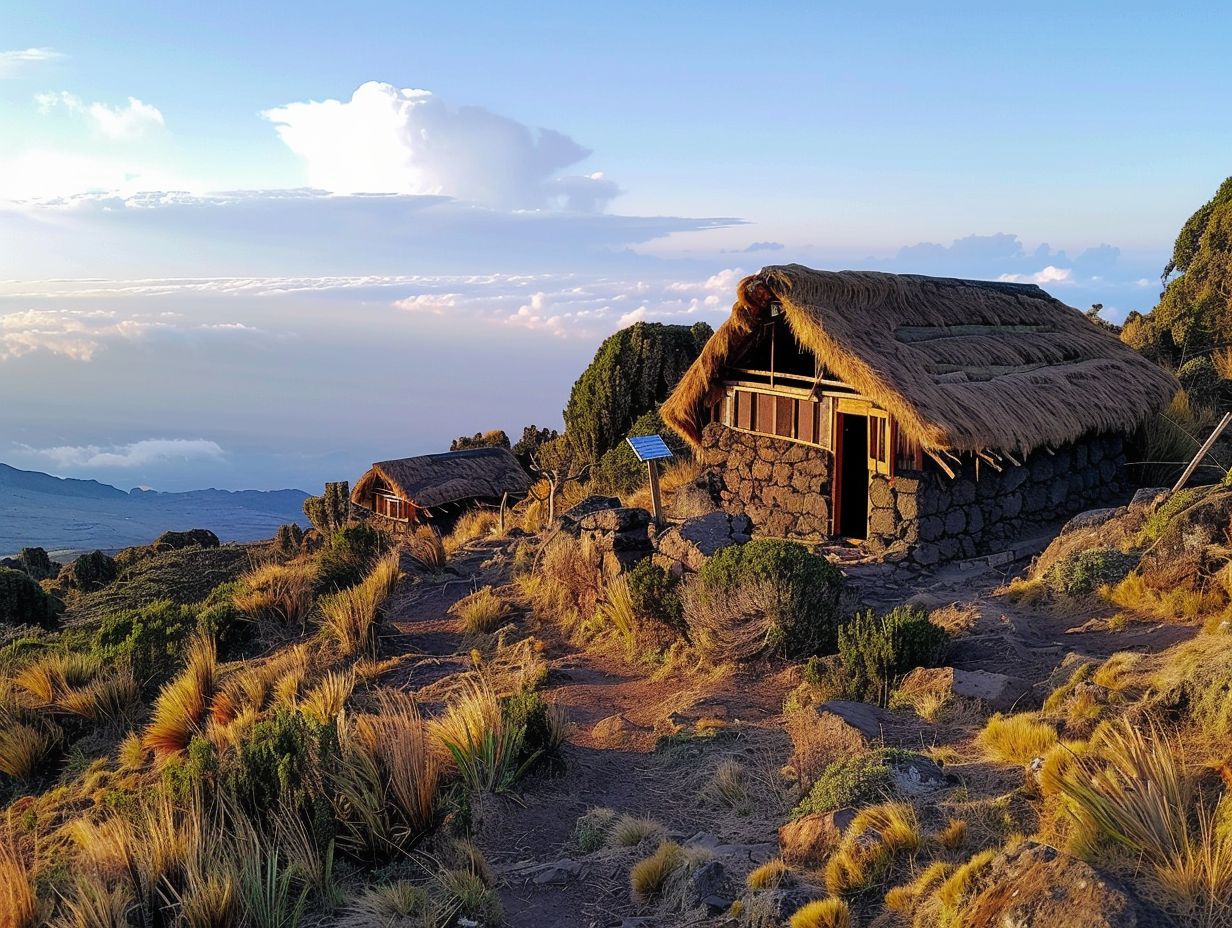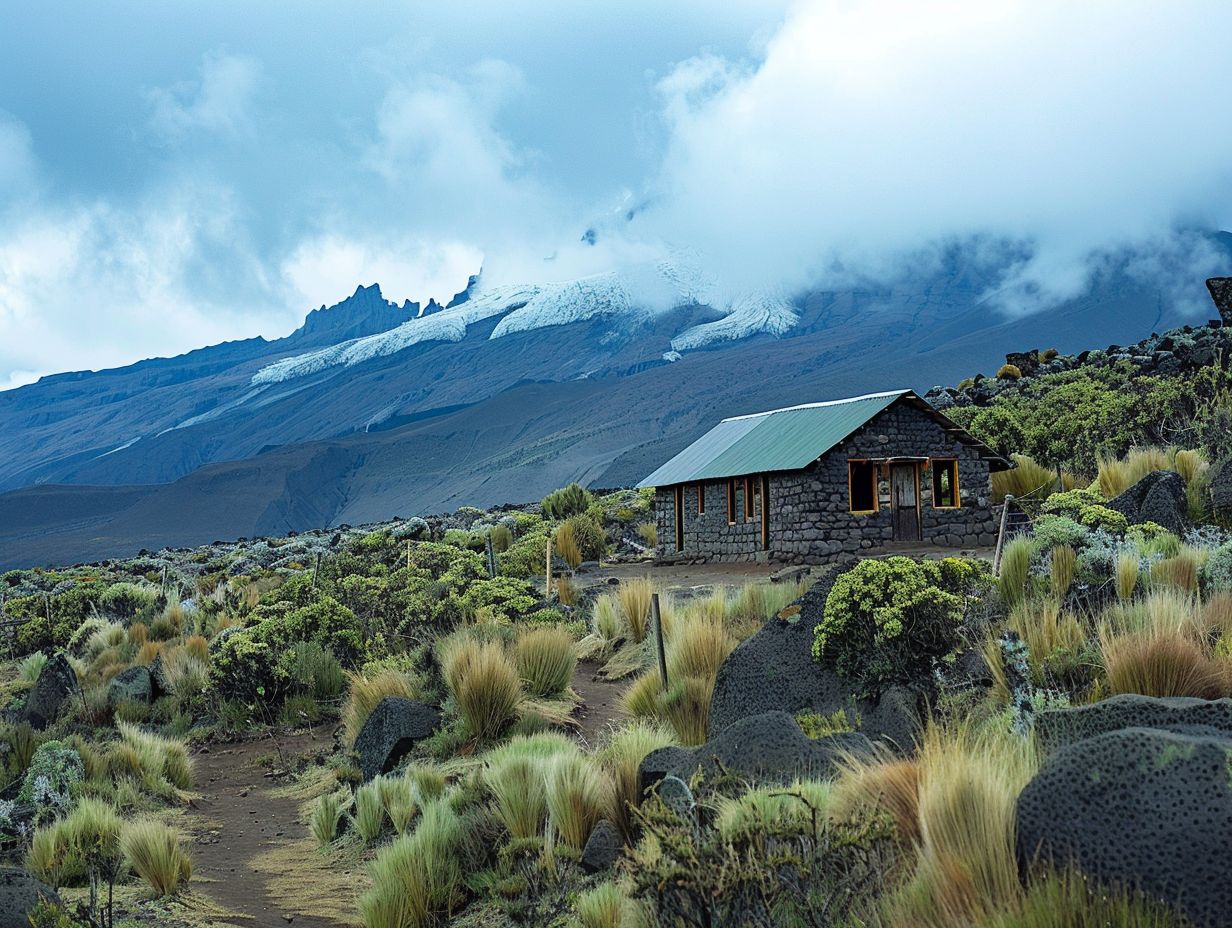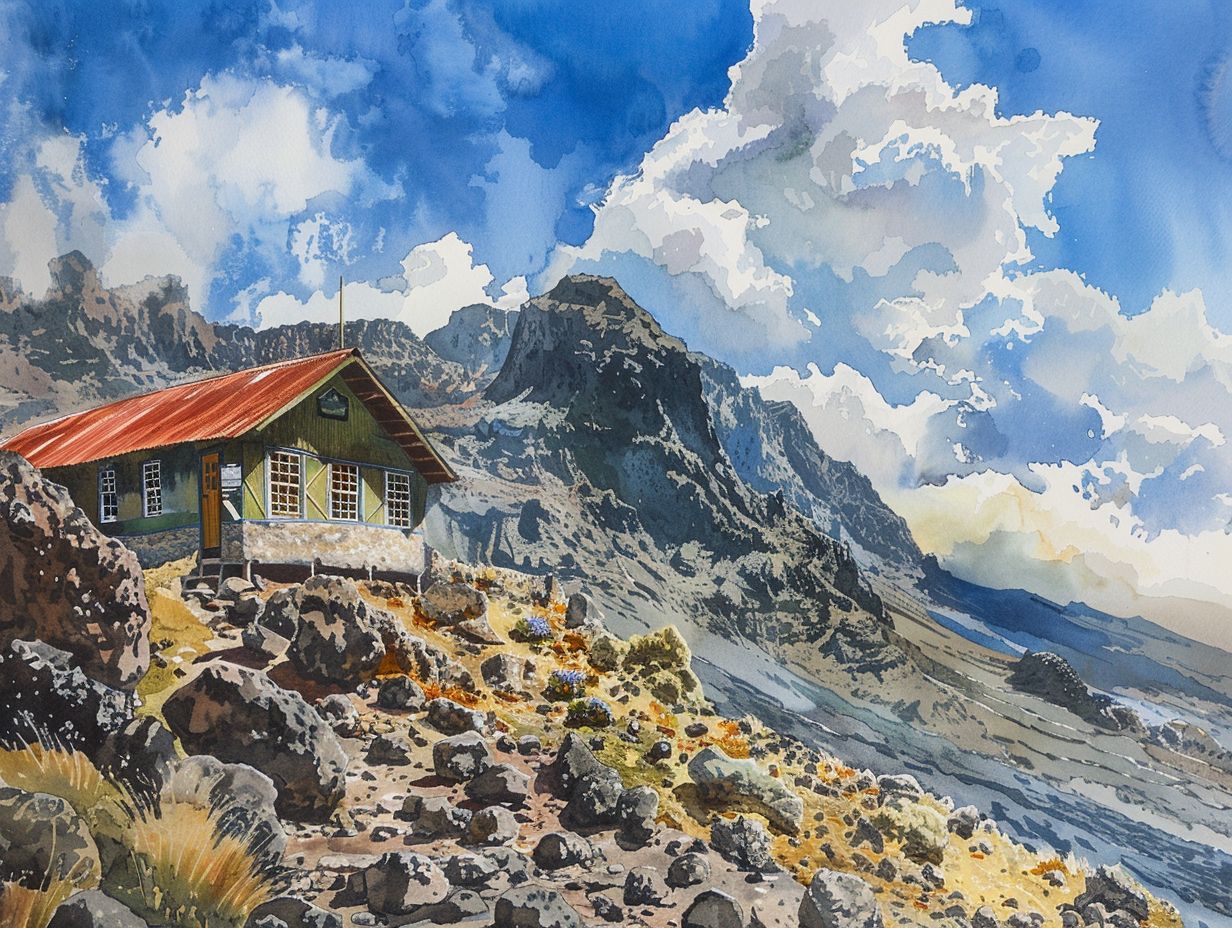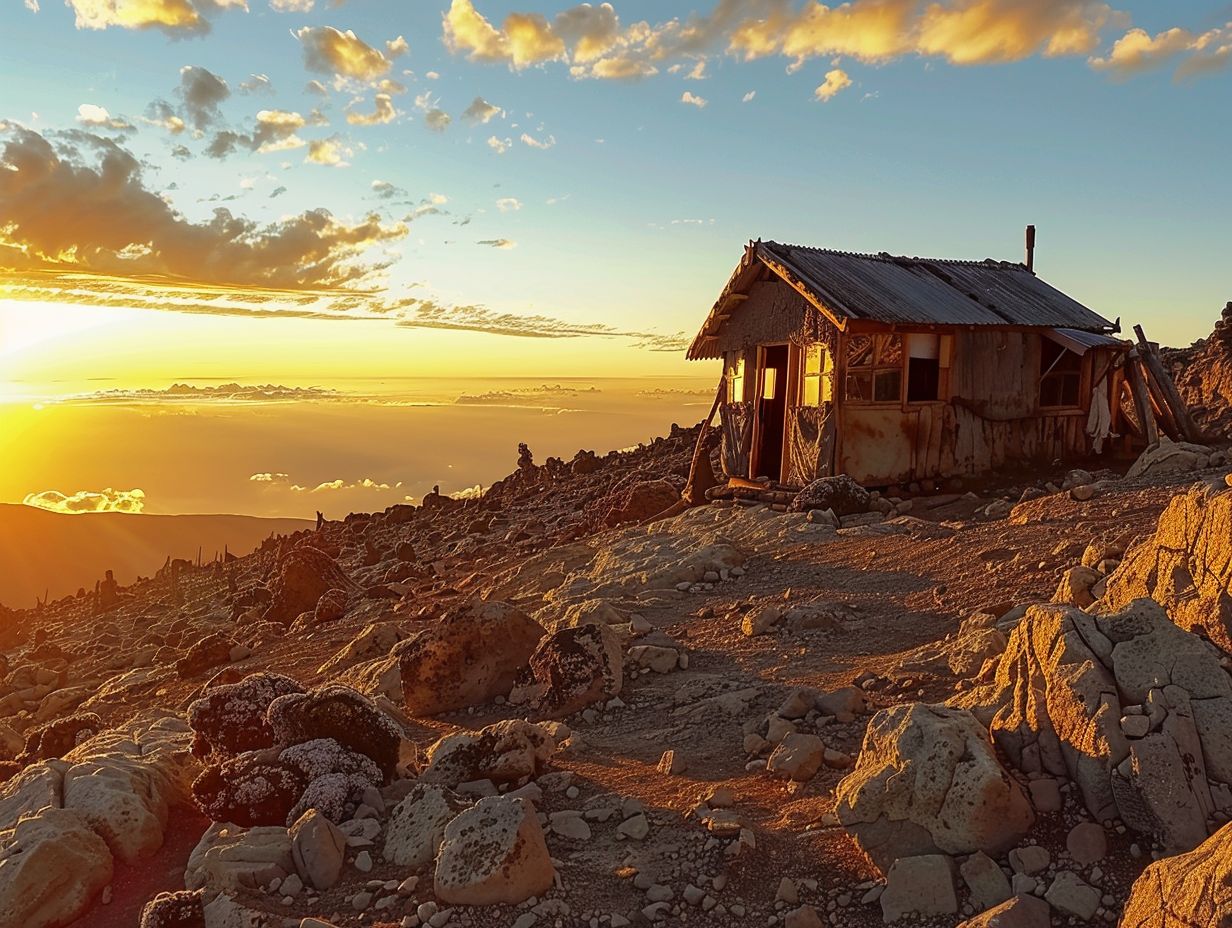
Kibo Hut Kilimanjaro
If you’re an adventure seeker looking to experience the breathtaking beauty of Kilimanjaro, then Kibo Hut is the perfect place for you. Situated at a high altitude, this hut serves as a key resting point for trekkers and hikers on their way to the summit.
In this article, we’ll explore the location, purpose, and accommodation options at Kibo Hut, as well as the activities you can enjoy and precautions you should take during your visit. So, let’s dive in and discover everything you need to know about Kibo Hut Kilimanjaro.
Key Takeaways:

- Experience the ultimate adventure at Kibo Hut Kilimanjaro, located at the foot of the majestic Uhuru Peak.
- Choose from various routes and plan for a minimum of 6-7 days to reach the hut, depending on your fitness level.
- Stay comfortably at the hut with basic facilities while enjoying activities such as hiking, wildlife viewing, and photography.
What Is Kibo Hut Kilimanjaro?
Kibo Hut Kilimanjaro is a crucial lodging point for climbers on their journey to reach the summit of Mount Kilimanjaro, the highest peak in Africa.
Situated at an elevation of around 4,700 meters, Kibo Hut serves as a vital resting spot during the challenging climb to Uhuru Peak. With its strategic location near the crater rim of Kilimanjaro, this mountain hut offers basic accommodation facilities, including dormitory-style rooms and common dining areas where climbers can refuel before their final ascent.
The hut plays an essential role in acclimatization, allowing climbers to adjust to the high altitude before tackling the demanding final stretch to the summit. Its proximity to the peak makes it a convenient starting point for the last leg of the journey.
-
Location of Kibo Hut:
Situated near the Kibo volcanic cone on Mount Kilimanjaro, Kibo Hut serves as a vital resting point for climbers aiming to reach the summit of Africa’s highest peak.
Kibo Hut’s geographical location at an altitude of approximately 4,700 meters places it strategically for climbers pushing towards the Uhuru Peak. The proximity to the Kibo volcanic cone not only offers a picturesque backdrop for hikers but also serves as a reminder of the mountain’s volcanic origins and unique geological formations.
Its role as a crucial campsite provides a much-needed refuge for trekkers during their multi-day ascent, allowing them to rest, acclimatize, and prepare for the final leg to the summit. The hut’s basic amenities, such as bunk beds and meals, offer climbers a temporary sanctuary amidst the harsh mountain environment.
-
Altitude of Kibo Hut:
Kibo Hut stands at a significant altitude on Mount Kilimanjaro, providing climbers with a strategic base camp as they acclimatize to the high altitudes of the mountain.
Located at an impressive elevation of approximately 4,700 meters (15,500 feet) above sea level, Kibo Hut offers a crucial resting point for climbers on their journey to the peak. This strategic location allows adventurers to adjust to the thinning air and decreased oxygen levels, essential for avoiding altitude sickness and ensuring a successful summit attempt.
-
Purpose of Kibo Hut:
Kibo Hut serves as a crucial accommodation facility and resting point for climbers on their arduous journey to summit the iconic Mount Kilimanjaro.
Located at an elevation of around 15,500 feet (4,700 meters) on the slopes of Kilimanjaro, Kibo Hut offers weary climbers a sanctuary to recharge and acclimatize before the final push towards Uhuru Peak, the highest point on the mountain.
The hut provides basic amenities such as bunk beds, meals, and shelter from the unpredictable mountain weather, allowing climbers to rest, refuel, and prepare mentally and physically for the challenging climb ahead.
As climbers ascend through the rocky terrain and diminishing oxygen levels, Kibo Hut stands as a beacon of hope, marking a significant milestone in their quest to conquer the ‘Roof of Africa’.
How to Reach Kibo Hut Kilimanjaro?
Reaching Kibo Hut on Mount Kilimanjaro involves navigating through designated climbing routes that cater to climbers seeking to conquer Africa’s highest peak.
One of the common routes to reach Kibo Hut is the Marangu Route, also known as the ‘Coca-Cola Route’, favored for its gradual ascent and comfortable huts along the way.
Another popular option is the Machame Route, providing stunning scenery but with more challenging terrain and steeper gradients.
For those looking for a more remote and less crowded experience, the Rongai Route offers a different perspective of the mountain, with the added challenge of approaching from the north.
Each route presents its own set of challenges, from altitude sickness to unpredictable weather conditions, making thorough preparation and acclimatization essential for climbers attempting to reach Kibo Hut.
-
Routes to Reach Kibo Hut:
Climbers can access Kibo Hut via popular routes such as the Rongai route or the Marangu route, each offering unique experiences and challenges on the journey to the summit of Kilimanjaro.
The Rongai route, known for its gradual slopes and scenic diversity, appeals to those seeking a less crowded path to the top. This route emanates a sense of solitude as climbers traverse through lush forests, contrasted by alpine meadows, granting a serene journey.
On the other hand, the Marangu route, dubbed as the ‘Coca-Cola’ route, due to its popularity and well-established hut system, provides a more social atmosphere among climbers. Travelers are treated to comfortable accommodations at designated huts along the way, making it a preferred choice for those prioritizing comfort and social interaction during their expedition.
-
Time Required to Reach Kibo Hut:

The time required to reach Kibo Hut varies for climbers depending on the chosen route, fitness levels, and altitude acclimatization, with most climbers taking multiple days to trek to this essential resting point on Kilimanjaro.
Fitness plays a crucial role in determining the pace at which climbers can ascend to Kibo Hut. Those with better physical conditioning often find it easier to navigate the challenging terrain, enabling them to progress more swiftly.
The process of acclimatization is essential for climbers to adapt to the increasing altitude and reduce the risk of altitude sickness. Proper acclimatization involves gradually ascending to higher elevations and allowing the body to adjust to the reduced oxygen levels. Climbers who prioritize adequate acclimatization are more likely to reach Kibo Hut comfortably and safely.
What Is the Accommodation Like at Kibo Hut Kilimanjaro?
Accommodation at Kibo Hut Kilimanjaro ranges from tents and huts to dormitory-style lodgings, providing climbers with essential shelter and comfort during their ascent to the summit of Mount Kilimanjaro.
For those seeking a more traditional camping experience, spacious tents are available, equipped with sleeping mats and warm sleeping bags to combat the high-altitude chill of the mountain nights. The sturdy huts at Kibo Hut offer a solid shelter from the elements, complete with wooden sleeping platforms and cozy blankets.
Climbers opting for dormitory-style accommodations will find shared sleeping quarters with bunk beds, perfect for socializing with fellow trekkers and sharing stories of the challenging climb. The communal dining area serves hearty meals that provide the necessary energy for the demanding trek ahead.
Types of Accommodation Available:
At Kibo Hut, climbers can choose between dormitories equipped with bunk beds, providing a communal lodging experience that fosters camaraderie among fellow climbers on the journey to Kilimanjaro’s summit.
These bunk beds are set up in shared rooms, where climbers can rest and rejuvenate before their summit push. The dormitory layout encourages interactions and shared stories among trekkers from diverse backgrounds and nationalities. The communal living environment at Kibo Hut creates a unique atmosphere of support and encouragement, enhancing the overall climbing experience.
With climbers sharing common spaces, such as dining areas and relaxation zones, friendships are often formed, and the sense of community is strengthened. The bunk bed accommodation at Kibo Hut is not just a place to sleep but a hub of connection and mutual support for those embarking on the challenging ascent of Kilimanjaro.
Facilities Available at Kibo Hut:
Kibo Hut boasts essential facilities such as a dining room, bunk beds, and amenities catering to climbers’ needs, ensuring a comfortable and convenient stay as they prepare for the final push to the Kilimanjaro summit.
The dining room at Kibo Hut serves hearty meals to replenish the energy of weary climbers after a long day of trekking. Nestled amidst breathtaking mountain views, climbers can enjoy their meals while relishing the stunning scenery. The bunk bed accommodations provide a cozy resting place where climbers can rejuvenate for their summit ascent.
Climbers have access to hot showers, essential for refreshing tired muscles and rejuvenating spirits on the challenging climb. Other important facilities include a communal space for socializing and bonding with fellow climbers, creating a sense of camaraderie and support during this arduous journey.
What Are the Activities to Do at Kibo Hut Kilimanjaro?
At Kibo Hut Kilimanjaro, climbers can engage in various activities such as hiking, trekking, wildlife viewing, and photography, immersing themselves in the natural beauty and diverse landscapes of Africa’s highest peak.
The Kibo Hut area offers an array of hiking trails that cater to different skill levels, from leisurely strolls to challenging ascents up the volcanic terrain. Adventurers can discover unique flora and fauna along these paths, including endemic species that thrive in the mountain’s high-altitude environment.
Wildlife enthusiasts will be delighted by the opportunity to spot native animals like rock hyraxes, birds of prey, and even occasional sightings of larger mammals such as buffalo or elephants farther below. These encounters truly enhance the immersive experience of being surrounded by nature at Kibo Hut.
For photography enthusiasts, Kibo Hut provides stunning vistas and captivating scenery at every turn. From the rugged slopes of Mount Kilimanjaro to the expansive views of the surrounding plains and valleys, photographers can capture breathtaking moments that showcase the grandeur of this iconic peak.
-
Hiking and Trekking:
Hiking and trekking around Kibo Hut offer climbers the chance to explore the mountain’s diverse terrain, from alpine deserts to rocky outcrops, providing a memorable outdoor experience amidst Kilimanjaro’s natural beauty.
The routes near Kibo Hut cater to all skill levels, with some paths leading through lush forests teeming with unique flora and fauna, offering a glimpse into the rich biodiversity of the area. As climbers ascend, the landscapes transition, revealing breathtaking vistas of distant peaks and glacier-clad slopes. One of the most remarkable aspects of trekking here is the opportunity to witness the interplay of light and shadow as the sun dances over the mountain, creating a magical atmosphere that is truly unforgettable.
-
Wildlife Viewing:
Wildlife viewing near Kibo Hut allows climbers to observe unique fauna and flora adapted to the high-altitude environments of Kilimanjaro, providing a glimpse into the natural wonders of the mountain ecosystem.
At Kibo Hut, situated at an elevation of approximately 4,700 meters on Mount Kilimanjaro, adventurers can marvel at the endemic plants such as the striking giant groundsels and eerie, otherworldly-looking lobelias that dot the rocky landscapes.
These plants have evolved to survive in the harsh conditions of the alpine zone, adding to the mystique of the trek. Regarding wildlife, lucky climbers may spot the agile and curious Kilimanjaro tree hyraxes, along with various bird species like the colorful Malachite Sunbird flitting through the skies.
-
Photography:

Photography enthusiasts visiting Kibo Hut can capture stunning images of the mountain’s snow-capped peaks, rocky landscapes, and alpine desert vistas, creating lasting memories of their Kilimanjaro climbing experience.
At Kibo Hut, the early morning light illuminates the majestic Uhuru Peak, the highest point of Kilimanjaro, casting a golden hue over the rugged terrain. Photographers can also focus their lens on the unique flora and fauna that thrive in this harsh yet captivating environment.
The contrast of the greenery against the stark backdrop of the mountain creates a striking visual composition. As the day progresses, the shifting clouds and mist add a sense of mystery and drama to the photographs. Whether capturing the sunrise or the starry night sky, every moment at Kibo Hut offers a new and breathtaking frame for photographers to seize.
What Are the Precautions to Take at Kibo Hut Kilimanjaro?
Before venturing further up Mount Kilimanjaro from Kibo Hut, climbers must be mindful of altitude sickness risks, changing weather conditions, and the necessity of appropriate gear and clothing for the challenging terrain ahead.
Altitude sickness can be a significant concern as climbers ascend higher. It is crucial to acclimatize properly by taking regular breaks and staying hydrated.
Being aware of the early symptoms, such as headaches or dizziness, can aid in timely treatment. Weather conditions on Kilimanjaro can vary rapidly, from scorching sun to freezing cold, so bringing layers and waterproof gear is vital. Thermal layers, moisture-wicking fabrics, and sturdy hiking boots are among the recommended gear to cope with the diverse weather conditions and rugged paths.
-
Altitude Sickness:
Altitude sickness poses a significant risk for climbers at Kibo Hut due to the high elevations, requiring proper acclimatization, hydration, and awareness of symptoms to mitigate potential health issues during the ascent.
Acclimatization, the process of allowing the body to adjust to higher altitudes, is crucial to reduce the risk of altitude sickness. Climbers should ascend slowly, taking regular breaks to allow their bodies to adapt to the thin air. Staying well-hydrated is vital to ward off dehydration, a common exacerbating factor for altitude sickness.
Recognizing symptoms such as headaches, dizziness, nausea, and fatigue is essential. If any of these signs appear, immediate action should be taken, including descending to lower altitudes and seeking medical help if necessary.
-
Weather Conditions:
The weather at Kibo Hut on Kilimanjaro can be unpredictable and harsh, with climbers facing extreme temperatures, humidity changes, snow, and high winds, necessitating suitable gear and preparations for varying conditions.
Being prepared for these diverse weather challenges is essential for climbers to safely conquer the mountain. The rocky terrains combined with sudden weather changes make the journey even more demanding.
Proper acclimatization becomes crucial as climbers ascend higher, combating altitude sickness and its associated symptoms such as dizziness and nausea. Along with the physiological aspects, mental resilience is tested in such unforgiving conditions, requiring determination, focus, and adaptability to persevere towards the summit.
-
Proper Gear and Clothing:
Climbers staying at Kibo Hut must ensure they have the proper gear and clothing, including insulated layers, waterproof outerwear, sturdy footwear, and essential equipment for the challenging terrain and weather conditions of Mount Kilimanjaro.
Layering is crucial for staying warm at higher altitudes, so pack multiple insulating layers such as fleece jackets, down vests, and thermal base layers.
A time-tested waterproof jacket along with pants can protect against unpredictable mountain weather. As for your footwear, opt for sturdy hiking boots with excellent ankle support and waterproofing. Other essential equipment includes a headlamp for early morning starts, a reliable backpack for carrying supplies, and trekking poles for stability on uneven terrain.
What Is the Best Time to Visit Kibo Hut Kilimanjaro?
The best time to visit Kibo Hut on Mount Kilimanjaro is during the dry seasons, typically from June to October and January to March, when climbers can enjoy clearer skies, stable weather conditions, and optimal visibility for the ascent.
During these dry seasons, precipitation is typically lower, reducing the chances of encountering rain or snowfall, which can impede progress and lower morale. This period also sees fewer clouds, offering stunning panoramic views of the surrounding landscapes, including the iconic glaciers of Kilimanjaro.
The moderate temperatures during these times provide climbers with more comfortable conditions for the strenuous journey. The drier air makes breathing easier at higher altitudes, which is crucial for acclimatization and overall well-being during the climb.
Choosing the right time to visit Kibo Hut can significantly impact the overall experience and chances of reaching the summit successfully. Therefore, planning your expedition during the favorable dry seasons improves your odds of a safe and rewarding Kilimanjaro ascent.
What Are the Other Nearby Attractions to Explore?
Along with Kibo Hut, climbers can explore notable attractions near Mount Kilimanjaro, including the iconic Uhuru Peak, the rugged Mawenzi Peak, and the breathtaking Shira Plateau, each offering unique perspectives and experiences for adventurers.
Uhuru Peak, the highest point in Africa, stands tall as a symbol of triumph and accomplishment for climbers reaching its summit. Mawenzi Peak, with its jagged peaks and challenging terrain, provides a thrilling adventure for mountaineers seeking a more demanding climb.
The expansive Shira Plateau, formed by volcanic activity, showcases panoramic views of the surrounding landscape and offers a serene setting for trekkers to rest and rejuvenate amidst the beauty of Kilimanjaro.
-
Uhuru Peak:

Uhuru Peak, the highest point on Mount Kilimanjaro, offers climbers a rewarding summit experience with panoramic views of the African landscape, making it a must-visit destination near Kibo Hut.
As climbers ascend towards Uhuru Peak, they are greeted by not only the stunning beauty of the surrounding landscape but also by a profound sense of accomplishment. Standing at an impressive elevation of 5,895 meters (19,341 feet), the peak provides unparalleled vistas that stretch out as far as the eye can see.
The feeling of reaching the top of Africa’s highest mountain is incomparable, with the immense glaciers, valleys, and plains below creating a surreal backdrop. It’s a moment that encapsulates both physical triumph and emotional awe, making it a pinnacle of achievement for adventurers from around the globe.
-
Mawenzi Peak:
Mawenzi Peak, a striking volcanic cone near Kibo Hut, offers climbers a rugged and challenging ascent, showcasing unique rock formations and dramatic landscapes for adventurers seeking diverse experiences on Kilimanjaro.
Surrounded by steep cliffs and valleys, climbers are greeted with a visual feast of jagged ridges and vertical walls on the way to the summit. These geological marvels, sculpted by ancient volcanic eruptions, provide a daunting yet awe-inspiring backdrop for those brave enough to take on the climb.
The harsh, unpredictable weather conditions and extreme altitude add an element of danger and excitement to the expedition, making it a true test of one’s physical and mental stamina.
-
Shira Plateau:
Shira Plateau, a vast high-altitude plateau near Kibo Hut, showcases unique vegetation and diverse flora, providing climbers with a picturesque setting for exploration and relaxation amidst Kilimanjaro’s natural beauty.
The stunning landscape of Shira Plateau features a rich tapestry of endemic plants, including giant lobelias and groundsel trees that thrive in this challenging environment. As climbers ascend towards the summit, they are greeted by the sight of moorlands covered in vibrant shades of green and yellow, a stark contrast to the rocky terrain below.
Exploring this botanical wonderland offers a close-up look at the resilience of plant life at extreme altitudes, with succulent species like the Dendrosenecio kilimanjari adding bursts of color to the arid landscape.
Frequently Asked Questions:
1. What is Kibo Hut Kilimanjaro?
A: Kibo Hut Kilimanjaro is a mountain hut located on Mount Kilimanjaro, the tallest mountain in Africa. It is situated at an elevation of 4,703 meters and serves as a resting point for hikers attempting to reach the summit.
2. How do I get to Kibo Hut Kilimanjaro?
A: You can reach Kibo Hut Kilimanjaro by trekking through various routes on Mount Kilimanjaro. The most common routes include the Marangu, Machame, Rongai, and Lemosho routes. You can also hire a guide or join a tour group to reach the hut.
3. What are the facilities available at Kibo Hut Kilimanjaro?
A: Kibo Hut Kilimanjaro has basic facilities such as bunk beds, toilets, and a dining area. However, it is important to note that the hut does not have running water or electricity. It is recommended to bring your own water and headlamps for lighting.
4. Is it necessary to stay at Kibo Hut Kilimanjaro?
A: No, it is not necessary to stay at Kibo Hut Kilimanjaro. Some hikers choose to camp at designated campsites along the trek, while others opt to reach the summit and descend back down in a single day. Staying at the hut is recommended for hikers who need a rest before attempting the final push to the summit.
5. What is the weather like at Kibo Hut Kilimanjaro?
A: The weather at Kibo Hut Kilimanjaro can vary greatly, but it is generally cold and windy. Temperatures can drop below freezing at night, so it is important to have proper cold-weather gear. The hut is also prone to fog and mist, so be prepared for limited visibility.
6. Is it safe to stay at Kibo Hut Kilimanjaro?
A: Yes, it is generally safe to stay at Kibo Hut Kilimanjaro. However, it is important to follow safety protocols and listen to your guide’s instructions. Altitude sickness is a real concern at this elevation, so it is important to acclimatize properly and be aware of any symptoms. It is also recommended to have travel insurance in case of emergencies.